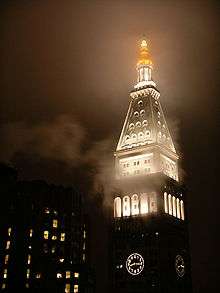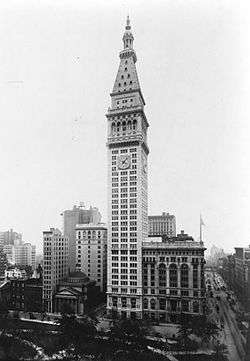Metropolitan Life Insurance Company Tower
| Metropolitan Life Insurance Company Tower | |
|---|---|
|
The Metropolitan Life Tower in 1911 | |
| Alternative names |
Met Life Tower Metropolitan Life Tower |
| Record height | |
| Tallest in the world from 1909 to 1913[I] | |
| Preceded by | Singer Building |
| Surpassed by | Woolworth Building |
| General information | |
| Type | Commercial offices |
| Location |
1 Madison Avenue[1] Manhattan, New York City |
| Construction started | 1905 |
| Completed | 1909 |
| Owner | Abu Dhabi Investment Authority |
| Height | |
| Roof | 213.36 m (700.0 ft) |
| Technical details | |
| Floor count | 50 |
| Design and construction | |
| Architect | Napoleon LeBrun & Sons |
|
Metropolitan Life Insurance Company Tower | |
   | |
| Coordinates | 40°44′28.46″N 73°59′14.64″W / 40.7412389°N 73.9874000°WCoordinates: 40°44′28.46″N 73°59′14.64″W / 40.7412389°N 73.9874000°W |
| Architectural style | Italian Renaissance Revival |
| NRHP Reference # | 78001874 |
| Significant dates | |
| Added to NRHP | January 29, 1972 |
| Designated NHL | June 2, 1978 |
| Designated NYCL | 1989 |
| References | |
| [2][3][4][5][6] | |
The Metropolitan Life Insurance Company Tower, colloquially known as the Met Life Tower, is a landmark skyscraper located on Madison Avenue near the intersection with East 23rd Street, across from Madison Square Park in Manhattan, New York City. Designed by the architectural firm of Napoleon LeBrun & Sons and built by the Hedden Construction Company, the tower is modeled after the Campanile in Venice, Italy.[7] The hotel located in the clock tower portion of the building has the address 5 Madison Avenue, while the office building covering the rest of the block, occupied primarily by Credit Suisse, is referred to as 1 Madison Avenue.[8]
Inside the building is the New York Edition Hotel, a 273-room luxury hotel that opened in 2015.[9]
Architecture

The tower was a later addition to the original 11-story, full-block Metropolitan Life Home Office building (the "East Wing"), which was completed in 1893 and was also designed by Napoleon LeBrun & Sons.[10] Plans for the tower were first announced in 1905.[11] In 1953-57, the original Home Office building was replaced with the current building, designed by D. Everett Waid. Then, between 1960 and 1964, the Tower itself was modernized by Lloyd Morgan and Eugene V. Meroni.[10]
There are four clock faces, one on each side of the tower, located from the 25th to 27th floors. Each clock face is 26.5 feet (8 m) in diameter with each number being four feet (1.2 m) tall. The minute hands each weigh half a ton. The original tower was sheathed in Tuckahoe marble, but during the 1964 renovation plain limestone was used to cover the tower and the East Wing, replacing the old Renaissance revival details with a streamlined, modern look. Much of the building's original ornamentation was removed.
At its southeastern corner, it includes an entrance to the 23rd Street New York City Subway station serving the 4 6 <6> trains.
History

In 1905, Metropolitan Life bought a lot at the southeastern corner of Madison Avenue and 24th Street, on which it intended to build a 560-foot (170 m) building.[8] Finished in 1909, the building served as world headquarters of the company until 2005.[8] It was the world's tallest building until 1913, when it was surpassed by the Woolworth Building.[8][12]
In the early 1950s, Metropolitan Life started to renovate its entire headquarters, as well as demolish auxiliary structures in lieu of a new limestone, art moderne building.[8] The tower, the sole remaining structure from the early 20th century, was extensively renovated from 1960–1964, and most of the ornaments on the tower's facade were removed or rebuilt during that time, including the clock and the pyramid-shaped roof.[8] The building was added to the National Register of Historic Places in 1972, designated a National Historic Landmark in 1978,[5][13] and a New York City landmark in 1989.[14]
A three-year exterior restoration project, which saw much of the building covered in scaffolding, ended in 2002 and added a new, computerized, multicolored nighttime lighting system, much like that of the Empire State Building; the colors change to denote particular holidays or important events. The gilded cupola at the very top of the building serves as an "eternal light" which stays illuminated even after the rest of the lighting system has been turned off for the night. The building figured prominently in the Metropolitan Life Insurance Company's advertising for many years, illustrated with a light beaming from the top of its spire and the slogan, "The Light That Never Fails".
In March 2005, SL Green Realty Corp. bought the tower, intending to convert it to apartments. In May 2007, the tower and adjacent air rights were subsequently sold for $200 million to Africa Israel Investments.[15] In 2011, Tommy Hilfiger and a partner signed a contract to buy the building for $170 million, planning to transform it into Hilfiger's first hotel, with luxury condos. However Hilfiger backed off the project in September 2011.[16] Africa Israel then sold the tower to Marriott International in October 2011 for $165 million. Marriott announced in January 2012 that they are converting the tower to the New York Edition Hotel.[17] "Edition" is Marriott's boutique hotel line, run in association with Ian Schrager. The three Edition hotels, in London, Miami and New York, were sold by Marriott in January 2013 for $815 Million to the Abu Dhabi Investment Authority.[18] The New York property was conveyed to its new owner on its completion. Marriott continues to manage the hotels under long-term contract. The hotel opened in September 2015.
Metropolitan Life North Building

By the late 1920s, the 1909 Met Life Tower and the 1919 North Annex were becoming too small to house the continuously growing activities of the Metropolitan Life Insurance Company. Looking to expand, the company considered building on a full block site between East 24th and East 25th Streets.
Ecole des Beaux Arts-educated architect Harvey Wiley Corbett left his position on the Rockefeller Center design team in order to take up this project in 1928 and was joined by prominent architect Dan Everett Waid. The final design for the new building was proposed as a 100-story tower that would thin out as it rose.[19] However, the onset of the Great Depression in 1929 caused the company to scrap plans for a giant skyscraper and instead built only a portion of the proposed tower. The North Building, completed in 1950, currently has a 32-story base for the proposed 100-story tower, built with the structural strength and the number of elevator shafts needed for a later completion.
Currently, the primary tenant of the Metropolitan Life North Building today is the investment banking arm of Credit Suisse.
The Metropolitan Life Home Office Complex was added to the National Register on January 19, 1996.[6]
In popular culture
- The clock tower is mentioned in the opening of Murray Leinster's 1919 story "The Runaway Skyscraper," the clock running backwards indicating that the skyscraper was traveling in time.[20]
- In the animated TV series Futurama, the tower is seen in the future as wider and its face replaced with a digital clock.
- In the video game Bioshock Infinite, the building is the location of Booker DeWitt's office.
- In Christopher Morley's 1919 book "The Haunted Bookshop" character Aubrey Gilbert "could see the ruby beacon on the Metropolitan Tower signal three quarters."
See also
References

- ↑ "NYCityMap". NYC.gov.
- ↑ Metropolitan Life Insurance Company Tower at Emporis
- ↑ "Metropolitan Life Insurance Company Tower". SkyscraperPage.
- ↑ Metropolitan Life Insurance Company Tower at Structurae
- 1 2 "Metropolitan Life Insurance Company Building". National Historic Landmark summary listing. National Park Service. 2007-09-15.
- 1 2 National Park Service (2007-01-23). "National Register Information System". National Register of Historic Places. National Park Service.
- ↑ "Before This Seven-Day Wonder in Construction Is Completed It Will Be Overtopped by the Tall Tower of the Metropolitan Life.; A Reminder of Venice. How the Tower is Built. The Struggle with the Wind. Differs from Other Skyscrapers. An Extraordinary View." The New York Times, December 29, 1907. p. SM5
- 1 2 3 4 5 6 Gray, Christopher (1996-05-26). "Streetscapes/Metropolitan Life at 1 Madison Avenue;For a Brief Moment, the Tallest Building in the World". The New York Times. Retrieved 2015-11-11.
- ↑ http://www.editionhotels.com/new-york
- 1 2 Mendelsohn, Joyce (1998), Touring the Flatiron: Walks in Four Historic Neighborhoods, New York: New York Landmarks Conservancy, ISBN 0-964-7061-2-1, OCLC 40227695, pp.22-23
- ↑ "500-Foot Tower To Replace Church". The New York Times. June 21, 1905. p. 14.
Metropolitan Life's Plans for a New Structure; Parkhurst's Church There; The Company Will Raze It and Erect There One of the Tallest Buildings In the World.
- ↑ "Met Life Tower Named A New York Landmark", The New York Times, June 14, 1989. p. B4
- ↑ George R. Adams (January 24, 1977). "National Register of Historic Places Inventory-Nomination: Metropolitan Life Insurance Tower" (PDF). National Park Service. and Accompanying 6 photos, exterior and interior, from 1950-1976 (1.28 MB)
- ↑ New York City Landmarks Preservation Commission; Dolkart, Andrew S. (text); Postal, Matthew A. (text) (2009), Postal, Matthew A., ed., Guide to New York City Landmarks (4th ed.), New York: John Wiley & Sons, ISBN 978-0-470-28963-1, p.79
- ↑ "Clock Tower at Five Madison Goes for $200 M". The New York Observer. May 15, 2007. Retrieved 1 March 2011.
- ↑ "Marriott Buys the Clock Tower". StreetBeat. Retrieved 2011-11-22.
- ↑ "Five New EDITION Hotels Announced for Gateway Cities" Marriott press release (January 19, 2012)
- ↑ Hotel News Resource (7 January 2014). "Marriott Sells Three EDITION Hotels for $815 Million".
- ↑ "Madison Sq Tower to Rise 100 Stories". The New York Times. November 3, 1929. p. N1.
Metropolitan Life Will Erect the Tallest Office Structure for Own Use on Whole Block. Unusual Design is Drawn Accommodation for 30,000 Workers --Moving Stairs Planned for the First Thirteen Floors. Will Occupy Entire Block. Light Value Stressed.
- ↑ Webster, Bud (2013). Past Masters, and Other Bookish Natterings. West Warwick, RI: The Merry Blacksmith Press. p. 164.
External links
| Wikimedia Commons has media related to Metropolitan Life Insurance Company Tower. |
- Statement of Significance as a National Historic Landmark
| Records | ||
|---|---|---|
| Preceded by Singer Building |
Tallest building in the world 1909–1913 |
Succeeded by Woolworth Building |
| Tallest building in the United States 1909–1913 | ||


